Exxaro Resource limited Report Selector 2018
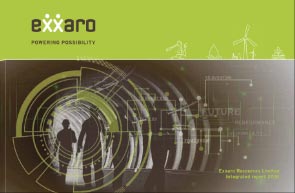
Currently viewing Integrated Report 2018
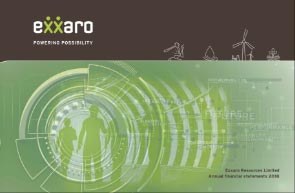
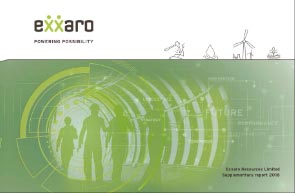
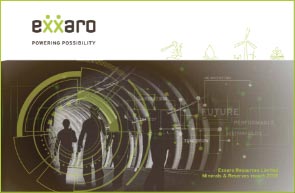

Currently viewing Integrated Report 2018



A matter is material if it is of such relevance that it could substantively influence the providers of financial capital's assessments of Exxaro's ability to create value over the short, medium and long term.
In determining whether a matter is material, senior management and directors should consider whether the matter substantively affects, or has the potential to substantively affect, Exxaro's strategy, business model, or one or more of the capitals it uses or affects.
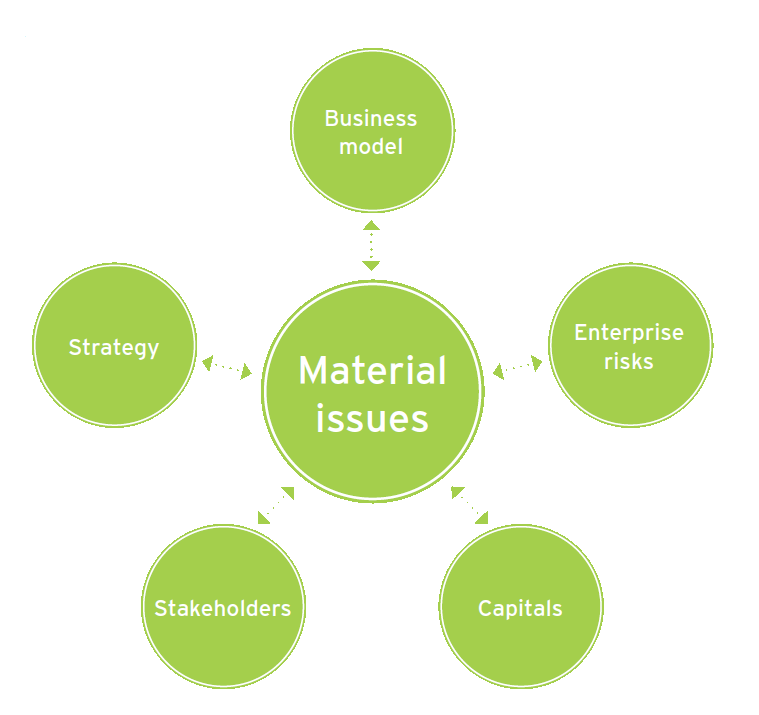
From the International
Integrated Reporting Council
Our material issues
Our material issues impact different areas of our business model, and are influenced by stakeholder issues and our operating context. The material issues, in turn, could influence the company's strategy to mitigate risks or take advantage of opportunities.
| Impacts/influences | ||||||||||||||||||||||||||||||||
| Material issue | Elements | Top 10 risk | UN Sustainable Development Goals (SDGs) |
Strategy | Business model |
Capitals | Stakeholders | |||||||||||||||||||||||||
Key customer dependency |
Domestic balance Exports balance |
|
8, 9, 12 |
✔ |
✔ |
|
✔ (customers) |
|||||||||||||||||||||||||
Our people |
Our employees Shared value |
|
1, 2, 3, 4, 5, 8, 10, 11 |
✔ |
✔ |
|
✔ (employees, communities) |
|||||||||||||||||||||||||
Business resilience |
Business excellence Coal: operational efficiencies Portfolio optimisation Business of tomorrow Innovation and digitalisation |
|
7, 8, 9, 12 |
✔ |
✔ |
|
✔ (employees, communities) |
|||||||||||||||||||||||||
Capital allocation – project execution |
Returns to shareholders Sustaining capital (stay in business) Expansion capital (growth) |
|
8, 9, 11, 12 |
✔ (focus on excellence) |
✔ (new business, business of tomorrow, agility and returns) |
|
✔ (investors) |
|||||||||||||||||||||||||
Social licence to operate |
Community investment Compliance (operations, projects) BEE transaction |
|
1, 2, 4, 5, 6, 10, 11, 13, 14, 15 |
✔ (strong CSI purpose) |
✔ |
Social |
✔ (communities, government, regulators) |
|||||||||||||||||||||||||
Exxaro relies on Eskom, the national power utility, and ArcelorMittal South Africa (AMSA) for 52% and 7% of its revenue respectively (2017: 54% and 6%). In 2018, sales volumes to Eskom were 70% of the total, in line with 2017.
| Coal sales (by product tonnes) (%) |
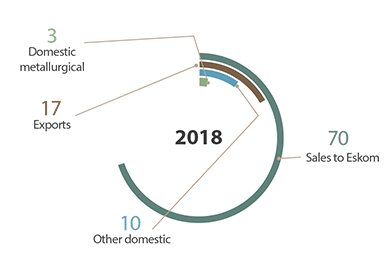 |
Eskom
The impact of our dependency on Eskom remained a key focus in 2018, specifically in light of ongoing concerns on the utility's financial and operational stability. On the positive side, our coal business is considered defensive, given long-term offtake agreements with Eskom for over two-thirds of coal produced to power South Africa. On the negative side, Eskom is also our single largest customer, making this relationship vital to our long-term future. Exxaro is committed to maintaining a positive and fruitful relationship with Eskom.
In the past three years, the relationship between Eskom and Exxaro has been tested, particularly in the tied and other coal segments (Matla and Arnot mines), and we had no alternative except arbitration to resolve some issues. Key developments on arbitration matters at Arnot and Matla are summarised below:
An additional risk to the stability of this relationship is Exxaro's shareholding structure. The reduction in our BEE ownership from just over 50% to 30% has been negatively received by Eskom in terms of its procurement policy and targets, although our contracts (which pre-date this policy) with the utility will not be affected by our decision to preserve and enhance black net asset value. We understand, however, that 50% BEE ownership has never been an official Eskom policy. As reinforced in numerous meetings with Eskom representatives, Exxaro is a South African company and we remain committed to meaningful transformation as opposed to meeting superficial equity targets.
AMSA
AMSA is also an important customer, consuming some 1Mtpa of our semi-soft coking coal to produce metallurgical and market coke. Exxaro will continue to supply this company under contractual requirements. Regular and amicable communication continues with AMSA at all levels. Apart from AMSA, the domestic market has limited uses for metallurgical coal. Accordingly, diversifying and creating alternate international markets has become imperative, and the focus in 2018 was to develop alternative niche export markets for a portion of our semi-soft coking coal volumes.
Exxaro recorded another fatality-free year in 2018, the third since inception in 2006. While we are encouraged by the steady improvement in our safety performance, we will not rest until fatality-free years become the norm, not exception. The relatively steady decrease in the lost-time injury frequency rate (LTIFR) over five years reflects the focus and commitment of all our people.
We recorded no labour unrest in the reporting period.
|
Employees Key performance indicators
|
||||||||||||||||||||||||||||||||||||||||||||||||||||||||||||||||
Safety
The safety of our people is fundamental to our business, and we will not rest until we consistently achieve our safety goals through collective responsibility, commitment and ongoing focus. As part of this focus, all operational business units have international health and safety accreditation (OHSAS 18001).
We have made steady progress over the past 13 years (see Safety and health of the supplementary report), proving that our target of zero harm is attainable.
The LTIFR was unchanged on 2017 at 0.12, and significantly below the peak of 0.42 in 2006. We recorded 23 LTIs against an aspiration of zero harm. The most common incidents were leg and ankle injuries followed by hand injuries.
We have focused programmes to empower safety, health and environmental representatives with the knowledge to identify risks better and contribute more effectively to reducing safety risks in the workplace.
In 2018, eight section 54 directives were issued by the DMR at Arnot, Grootegeluk and Matla for identified non-compliance. We have maintained a positive trend since 2010 in reducing directives, reflecting the benefit of an internal section 55 inspectorate programme at all business units, authorising appointed employees to stop unsafe activities and, in time, prevent accidents.
Health
Twelve occupational disease cases were accepted and 65 cases reported in 2018, bringing the OHIFR to 0.33 against a target of 0.31.
Given the importance of the health and wellness of our employees and contractors, we introduced the OHIFR three years ago and we are driving awareness to improve the health of all our people.
A key focus remains lifestyle diseases, which are proving a significant health risk for Exxaro.
Labour stability
Labour stability is one of the mining industry's key challenges. Despite the often-volatile nature of our industry, we are maintaining a stable labour climate across Exxaro, always aiming for crucial interactions with organised labour that are constructive and indicate improving relationships. These positive union relationships are sustained through functioning engagement structures and constructive processes to resolve issues. Apart from engaging with our union stakeholders, we also continuously engage with our entire workforce through CEO interaction at business units and the corporate office, as well as line management communication on operational issues.
The advent of multiple unions as opposed to traditional mining unions has changed the collective bargaining environment significantly over recent years. As a company, we have successfully adopted a pluralist approach to union recognition, and through appropriate governance, we have enjoyed labour stability.
Employment equity
We continue to focus on transforming our organisation. Since Exxaro's inception 13 years ago, developing skills levels across the business has been the cornerstone of successfully implementing our employment equity plans.
Our statutory annual reports were submitted for the last reporting cycle. Although we have achieved our targets at the middle and junior management levels, our challenge is with senior management and people with disabilities. New targets were published in September 2018, with a five-year compliance time frame.
Our women-in-mining focus is a key enabler for women to enter careers in our industry. Women currently comprise some 22% of the workforce, and we focus on attracting women through our talent pipelines. While this is a challenge, women now constitute 40% of young professionals in training, 36% of our full-time bursars in engineering and mining at universities. Black women represent 28% of the learner pipeline across the group.
Skills development
Given the importance of skills in our industry, we endeavour to invest an appropriate amount of total salaries and wages each year in developing our people.
In 2018, we spent R260 million on training for all employees, or 6.3% of payroll (2017: R224 million or 6.20%), including:
Talent sourcing
Talent is sourced primarily from the communities where our business units are located. The bursar, internship, learnerships and skills development initiatives that form part of Exxaro's talent sourcing are geared to empower local communities to compete for positions in the company. At present, 100% of our labour is sourced in South Africa.
Graduate programme
Our three-year professionals-in-training programme blends academic theory with practical exposure in the workplace. Each graduate has a mentor who supervises their technical, leadership and management training at operations. Mentors also assist with fulfilling professional registration requirements. In 2018, there were 75 professionals in training (2017: 61) throughout Exxaro in a R29.3 million programme. Of these interns, 29% are black women and 67% are black people, with 73% placed throughout the group. The remaining participants were retained for placement as vacancies open.
Bursary programme
There are currently 59 bursars studying at South African institutions at a cost of R4.5 million per annum. Over 75% are black South Africans and 25% are black women.
These bursaries are for school leavers from our communities interested in technical disciplines such as engineering (metallurgical, chemical, mechanical, electrical, industrial, mining or civil), mine surveying and geology. This has been adjusted to align with the four and five-year BEng programme.
Communities
The number of community-based protests continues to rise. These affect our employees directly through a physical inability to get to work but also often manifest through interactions with labour as an expectation that mining companies must create employment opportunities and facilitate enterprise development (to fill the void caused by a lack of service delivery) by developing infrastructure such as roads and bulk water supply.
As a mining company, balancing the strategic imperative for higher employee productivity with increasing demands from unions and communities for fair wages and community benefits can affect labour stability.
We began implementing a revised approach to enterprise and supplier development in 2017, focused on establishing entrepreneurs who will be able to create employment and business opportunities in their communities. We established the appropriate forums, processes and systems to enable socio-economic progress through enterprise and supplier development. In the Lephalale community, for example, we discussed with the local municipality the detail of the Grootegeluk SLP for 2018 to 2022 that responds to some of the infrastructural challenges in that municipality.
Apart from non-financial support at our business hubs, the enterprise and supplier development (ESD) programme provides loan and grant funding to qualifying suppliers and small enterprises. In 2018, we disbursed grant and loan funding of R180 million to 24 small enterprises through our ESD programme.
The company’s medium to long-term goals include becoming a leading provider of underground ventilation and roof-support services, as well as diversifying into manufacturing consumables used in the mining sector for coal production.
Due to the cyclical nature of commodities, management continuously evaluates the portfolio of projects and capital allocation, ensuring a robust portfolio that can withstand changes in the global economy.
In evaluating our projects, we consider macro-economic fundamentals, long-term commodity outlook, remaining life of each asset and the ability of each asset to deliver healthy returns under these changing conditions.
Last year, we strengthened our coal portfolio by divesting from assets close to their end of life, such as North Block Complex, while allowing for greenfield growth via Belfast and organic growth at long-term strategic assets. Optimising retained assets in our portfolio is a primary focus and aimed at improving their cost-curve position
Aligned with our longer-term strategy, we continually evaluate the role in our portfolio of reductants, iron ore (SIOC), zinc (Black Mountain and Chifeng) and energy (Cennergi).
In line with our portfolio-optimisation strategy, we sold 22.4 million Tronox shares in October 2017, raising R6.5 billion. We will continue to look for opportunities to divest from our remaining shareholding to focus on creating value in our core operations, fund capital programmes, redeem debt and return excess cash to shareholders. We also believe the timing could be opportune to begin disposing of our stake in Black Mountain.
Management will continue optimising the asset portfolio through a robust process, ensuring sustainability, growth and shareholder return.
| Specific projects are detailed on Material Issues, while specific initiatives to enhance business resilience are summarised on Performance Against Strategy |
Business excellence
Our business excellence function was launched in January 2018 to instil a culture of continuous improvement at Exxaro's corporate centre based on the Lean methodology, adapted from the world-renowned Toyota production system. Over the year, the focus of business excellence was expanded to cover all support functions in the group:
Strategy
The business excellence strategy has been built around three pillars:
| Implementation is closely aligned with our Connect2Next initiative (Risks and Opportunities of the supplementary report) to ensure we achieve the desired behaviours |
Highlights of 2018
The business excellence team also played a role in the ECC post-implementation review and mineral succession programme. The first focused on a number of elements of the ECC acquisition, integration and current operations to capture learnings that will be applied to future transactions of a similar nature. The second will help bring new ways of working and thinking to identify opportunities to create sustainable economies that leverage the assets and skills around our operations.
Where to next?
In 2019, we aim to entrench excellence thinking at the corporate centre and support our functions in rolling out strategic initiatives and excellence leadership systems that are aligned to Exxaro's strategic objectives and have the potential to deliver significant performance improvements and value uplift.
Digitalisation
The Exxaro digitalisation and innovation journey is a strategic initiative driven by the CEO that is now an integral part of our 2026 strategy.
In 2017, we conducted a digital assessment and developed a roadmap. During the assessments, we identified business-use cases that would assist in realising strategic operational initiatives, and the infrastructure requirements to support future digitalisation efforts.
In 2018, we launched the Digital@Exxaro programme with a strategy and vision focused on intelligent integration into our value chain and eliminating constraints to enable effective and optimised work execution in real time. Essentially, this would introduce Exxaro to new ways of managing variability and enhancing productivity - resulting in increased throughput and improved safety.
We have made significant progress, with all operations implementing the first versions of cross-value chain visualisation and an integrated operations centres (IOC):
Major Digital@Exxaro initiatives
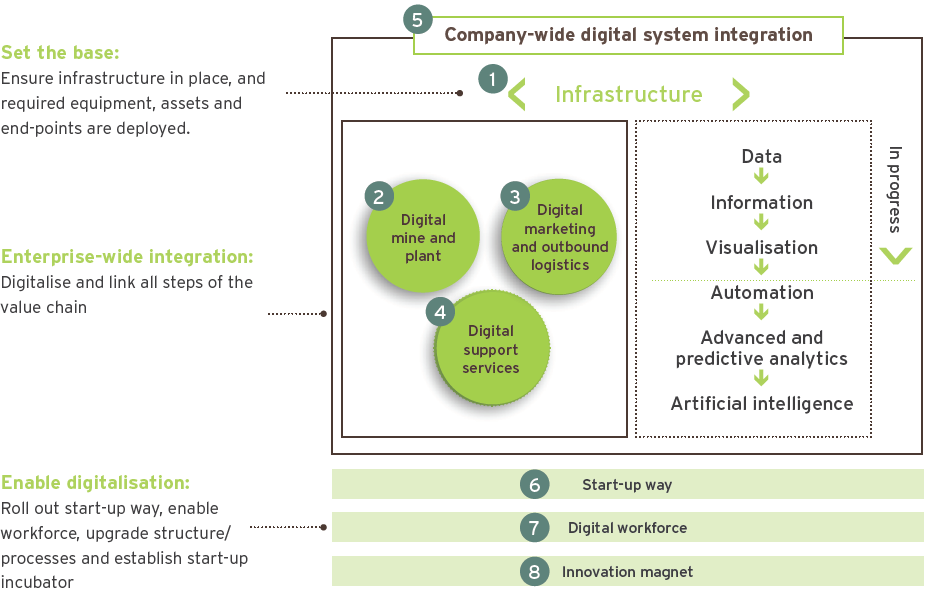
Exxaro needs to remain abreast of developments in innovation, given the pace at which solutions are being developed across multiple industries. We need to be able to identify and evaluate these developments in terms of maturity and applicability, identify where the biggest value can be created and in an agile, but structured, way implement and adopt new technologies and innovations.
Intelligent automation
The process of intelligent automation is integral to our digitalisation programme and new ways of working, all aligned to achieving our business strategy. Intelligent automation empowers our people by deploying 'digital employees' to free up time for value-adding activities while using specialised software to automate and standardise repetitive, routine tasks and processes.
Intelligent automation delivers significant value and benefits to our business in both the front- and back-office environments by improving the accuracy, control, management and throughput of our processes while alleviating the burden on our employees.
We have defined key value drivers for identifying automation potential in business processes:
We have established a centre of excellence for intelligent automation to ensure we have the internal capacity to leverage associated opportunities in future. To date, this centre of excellence has automated and deployed processes in:
Intelligent automation enables our people to refocus their energy on more exciting, challenging and fulfilling work that supports our purpose. It presents an opportunity for all our employees to participate in this transformation, learn new skills and gain confidence in line with changes in the new world of work.
Our people are at the heart of this journey and we view their passion and imagination as critical ingredients to succeeding with this initiative.
In terms of capital management, we remain prudent by striking a balance between returning cash to shareholders, managing debt, and selectively reinvesting for the growth of our coal business.
To this extent our board has approved a revised capital allocation framework which is set out in the Report of the directors of our annual financial statements for the year ended 31 December 2018
Salient features of our capex in 2018 include:
| At R5 790 million | Capital expenditure increased by 48% from 2017 | ||
| R2 847 million (2017: R2 977 million) |
Was applied to sustaining and environmental capital (stay-in-business capital) | ||
| R2 943 million (2017: R944 million) |
Was invested in new capacity (expansion capital) | ||
Growth projects
Leeuwpan life extension
The focus is on the relocation action plan, with completion scheduled for December 2019.
Dorstfontein West 4 seam project
Construction work is progressing well, and the procurement process for bunker construction will be finalised in the first quarter 2019. The project is on plan and within budget.
Belfast project
The Belfast project spent R956 million in 2018. It is ahead of schedule (actual progress of 56% against plan of 52%) and ended the year with 1 780 615 LTI-free hours.
Thabametsi mine (IPP phase 1)
Exxaro and Marubeni/Kepco (lead developers of the Thabametsi IPP) continue to engage on the definitive coal-supply agreement and associated infrastructure agreements. After three major banks indicated they would not continue, the IPP is considering options to bridge the funding gap or reduce the capacity of the power station. No formal plans were communicated to Exxaro and all negotiations are on hold until we receive clarity on the way forward.
After the project team had consolidated and updated project information to ensure an effective start-up, team members were assigned to other projects in Exxaro. This reduced expenditure while retaining the ability to mobilise the project team when required.
Grootegeluk GG6 expansion phase 2
We have resolved a technical issue on the 6 000t silo with the contractor, and rectification work is progressing as planned.
Although contractor strikes and community unrest have led to numerous delays and put the project under pressure, it is on schedule and budget, with close expected in mid-2021.
Grootegeluk rapid load-out station
Commissioning will start in March 2019 and run through to July 2019.
Strikes by contractors and labour unrest in Marapong have delayed the project. While the project is currently within the approved board mandate, the team is under pressure to complete certain aspects of commissioning by July 2019.
Eskom-funded Matla expansion projects
Four interrelated projects are in different phases:
Empowered shareholding
When Exxaro was formed in November 2006, our empowerment shareholders were restricted from selling their shares to non-HDSAs for 10 years, commonly referred to as a lock-in period. This expired in November 2016.
Exxaro supports transformation through economic empowerment ownership, among others. We strongly believe our replacement BEE transaction, implemented in December 2017 after our initial BEE shareholding agreement expired in 2016, will create wealth through a reduced risk profile that contributes to sustainable empowerment. The new structure is less risky and more flexible - important in a cyclical industry. Exxaro has given BEE investors greater flexibility through a range of liquidity options, but structured so that our black shareholding will never drop below the level required for compliance or contractual purposes.
Following publication of the new mining charter, we are investigating the most appropriate structure for an employee and community share ownership plan, as previously committed.
The regulatory universe for mining is extremely stringent and spans the environmental, social and governance domains. For Exxaro, our licence to operate is key to a sustainable business - without the required authorisation in the social and environmental domains, we are not able to operate at all. These domains are governed by the mining regulator - the Department of Mineral Resources - as well as the departments of environmental affairs, and water and sanitation.
As a 30% black-owned entity, Exxaro strives to be a champion for empowerment and transformation and we are actively involved in the Minerals Council, where we contribute to shaping our regulatory universe. Our CEO, Mxolisi Mgojo, is also president of the council.
An important component of our sustainability as a company is our ability to comply with every stipulation, provision or directive in our various environmental licences. As an industry, mining has a negative impact on the environment, and is regulated by strict rehabilitation and closure laws. We follow a principle of zero harm and continually seek ways to minimise our impact on the environment.
Exxaro's active operations have all the authorisations required to operate under a valid mining right. All mining rights in turn need a valid and approved mine works plan (MWP) and approved SLPs. Under the new National Environmental Management Act, environmental authorisations are also required for a valid mining right. The only exceptions are:
All documentation and requests for execution for Strathrae and Tshikondeni were timeously submitted, but a decision taken not to execute as these mines are in closure. There is ongoing engagement with the DMR on the status of these rights.
Exxaro sees itself as the tenant in its host communities, and a successful relationship with communities is key to our business success and growth. In addition to our SLPs, we invest in areas such as environmental conservation and health and welfare through our corporate social investment (CSI) programmes.
Our aim is to create economic diversification to limit dependency on the mine while building resilient and self-sufficient communities in the long term by implementing local development initiatives to improve social infrastructure and education as well as promoting employment and local procurement.
Between 2006 and 2018, our focus on education and skills development accounted for 11.6% of our R534 million socio-economic expenditure.
In the prior year, we reached the end of a five-year cycle (2013 to 2017) for some SLPs, including Grootegeluk, Tshikondeni, Arnot, North Block Complex's Glisa and Eerstelingsfontein. Given challenges in the early stages of some projects, including approvals from relevant officials, implementation was delayed and these projects carried over into 2018 to meet our obligations.
A draft SLP for Grootegeluk awaits approval from relevant stakeholders, including the Lephalale local municipality.
At Thabametsi, the Lephalale local municipality requested a review of approved local economic development (LED) projects in the 2015 to 2019 SLP. We continue to negotiate with the municipality to finalise the matter.
Due to the unplanned closure of Arnot, Exxaro and Eskom began lengthy negotiations on how the closure SLP would be funded. After agreement was reached, the SLP was submitted in 2018.
New SLP submissions for North Block Complex's Glisa and Eerstelingsfontein as well as the closure SLP for Tshikondeni were finalised in 2018.
SLPs for Leeuwpan and Matla cover 2015 to 2020 while Belfast's SLP spans 2014 to 2018. The Belfast 2019 to 2023 SLP engagements are under way.
As part of the project lifecycle-planning process, Exxaro ensures that all requisite rights, licences and authorisations are in place prior to construction and commissioning.
The only exceptions occur after a stakeholder appeal.
Exxaro aims to have every mining right valid and to comply with all conditions for each licence and right granted. We define the validity of a mining right by having its three pillars in place: the MWP, environmental management programme (EMP) and SLPs.
Our analysis shows our mining rights are 98% valid, largely due to the rights of Strathrae and Tshikondeni not being executed. Given their closure status, they do not have valid MWPs and SLPs in place.
We define the enforceability of our mining rights by sections 93 and 47 directives issued, as well as any section 102 to amend an MWP, environment authorisation (EA) or SLP. In addition, compliance includes submitting reports to the DMR describing future mining activities.
We gave ourselves a conservative enforceability score of 75%, as we are currently integrating ECC's monitoring and compliance systems with Exxaro's compliance matrix. We expect the enforceability score to improve to above 95% once integration is complete.
Exxaro complies fully with all authorisations and licensing requirements for its current operations and projects. These authorisations typically include:
Each of these has specific conditions to which mining operations have to adhere at all times.
We measure environmental authorisations on two levels: IWULs granted, and environmental impact assessments approved. Our analysis shows that our environmental authorisations are within tolerable levels (95%), with the shortfall being due to delays in finalising appeals lodged against the Thabametsi and Belfast projects.
A compliance score of 90% to environmental authorisation conditions was provided by an internal audit. We implemented a new integrated monitoring and compliance system to help us improve the score in 2018. As part of this process, detailed checklists per site are being drafted to drive improved compliance to conditions.
Delays and appeals against IWULs granted by the Department of Water and Sanitation have become a risk for new projects and part of their critical paths. To mitigate the long lead times in securing the necessary permits and licences, we are engaging early with the respective regulators, and proactively with every interested and affected stakeholder group.
Our greenhouse gas (GHG) emissions are not an immediate risk to our licence to operate. However, related legislative developments such as GHG reporting regulations, carbon tax, carbon budgets and carbon offset systems will introduce additional compliance requirements.
As climate change affects our business, measuring specific indicators across our business units enables us to prioritise our actions and resources to address the greatest impacts. Since 2009, Exxaro has participated in the global CDP (the benchmark on climate change disclosure) and our carbon emission reporting systems are mature. We are now focused on developing mitigation and adaptation plans for all operations.
We measure the GHG impact across all business units to inform our strategy, set targets and report performance across the group. We base our accounting and reporting for GHG emissions on the Greenhouse Gas Protocol and have elected to use the operating control accounting approach for emissions. Given rising stakeholder activism against coal as a source of energy, Exxaro has responded to shareholder enquiries on our strategy to reduce emissions, transition to renewable energy and adapt to the so-called 2�C climate environment (limiting the increase in global temperature to below pre-industrial levels).
With the current and expected outlook for South Africa's electricity requirements, we believe coal remains a relevant source of affordable electricity generation for the economy and Exxaro is well positioned to supply this energy source to Eskom. We do, however, regard this as a medium to longer-term risk and it is part of our diversification imperative.
Total CO2 emissions for 2018 were 73 795 kilotonnes (kt) compared to 77 325kt in 2017. The decrease of 5% reflects a decrease in rehabilitation activities at some operations. Our short-term carbon intensity target is -5% on the prior-year level across the group. This is ambitious as some projects take time before their impact is evident, particularly for carbon intensities. We performed ahead of target, with carbon intensity of 5.3kt CO2e per total tonnes mined compared 5.4kt in 2017. Much of this is due to energy initiatives at Grootegeluk and Matla, such as energy monitoring and the 1MW solar grid project.
Diesel and electricity remain the biggest components of our GHG footprint. Currently we are addressing energy security, economic productivity and environmental impacts in our drive to become carbon neutral and thrive in a low-carbon economy.
Exxaro performed well on both CDP climate change and water disclosure for 2018, indicating leadership and the group's commitment to climate change mitigation and adaptation, as well as addressing and managing water risks.
South Africa is a water-scarce country and we recognise that water-reduction initiatives are crucial to sustainable operations, particularly under prevailing drought conditions.
Our group water strategy was approved in 2017. It is informed by our risk assessments and identifies five strategic focus areas of excellence:
Group water intensity decreased 30% in 2018 from the baseline. This primarily reflects reduced water withdrawal from Mokolo dam at Grootegeluk which substantially increased its use of stored pit-water in its processes as a temporary measure to reduce pit water levels.
As part of our commitment to water efficiency, and outlined in our strategy, we have finalised long-term, operation-specific water-intensity targets for 2018 to 2022. These are based on the prior two years' consumption (baseline) and target water withdrawals from natural resources. To ensure targets are achievable, we conduct water efficiency assessments every six months to assess progress and identify opportunities.
| Greenhouse gas emissions – Scope 1, 2 and 3 |
 |
The amended codes of good practice with more stringent targets were introduced in 2015. Exxaro's BEE verification in early 2017 highlighted a risk in the enterprise and supplier development (ESD) element, which affected our BEE contribution status. Compliance risks for the other elements have also been analysed and we are pleased to note that Exxaro's compliance for the ownership element is already at 100% and the other elements are performing well.
Structures have been put in place to focus on the ESD element for compliance but, more importantly, the need to develop sustainable small enterprises that create jobs for our unemployed youth. We believe we have the resources and skills to address the national issues of unemployment, inequality and poverty through our ESD and community development programmes.
A challenge in the amended codes is the target set for people with disabilities at 2% of the workforce. We are currently 40% below this target and actively driving disability awareness campaigns to identify employees with verifiable disabilities. In advertising careers, we emphasise the fact that a disability is not a barrier.